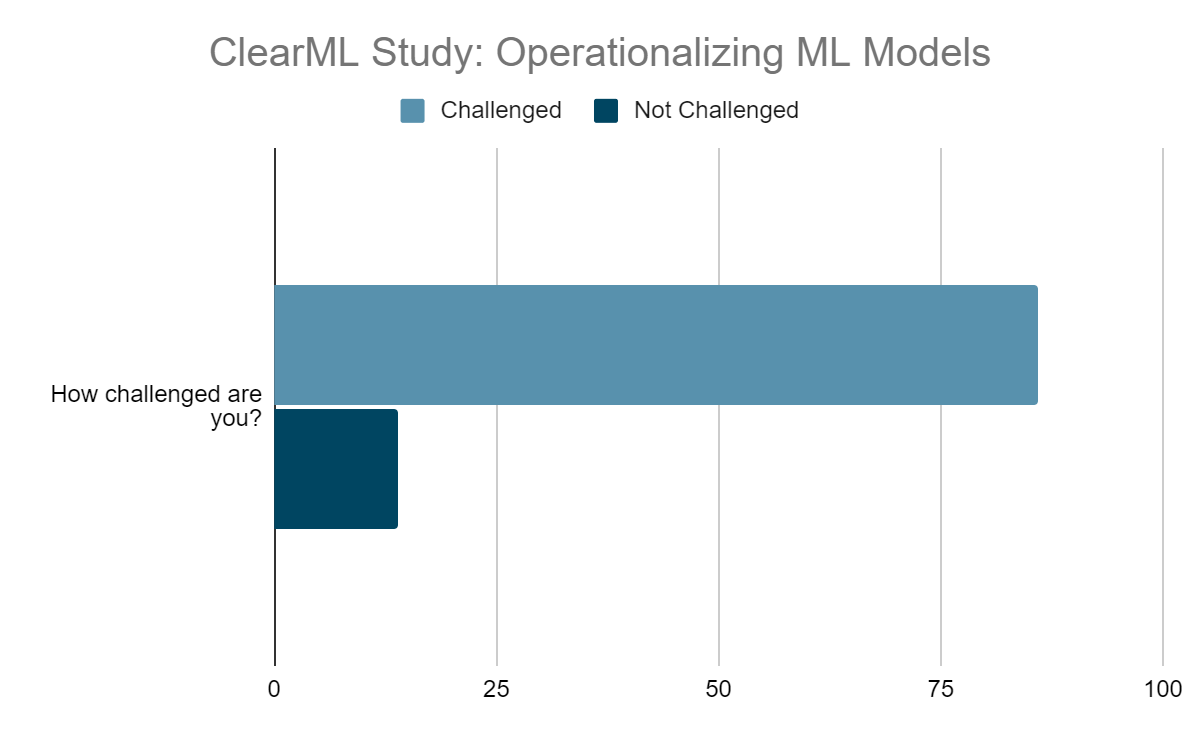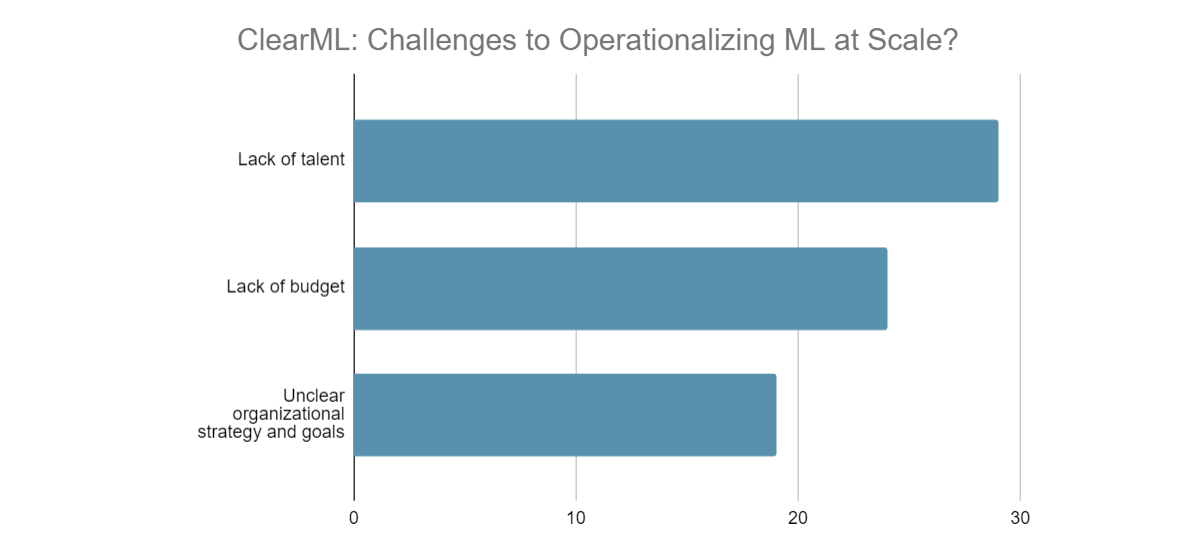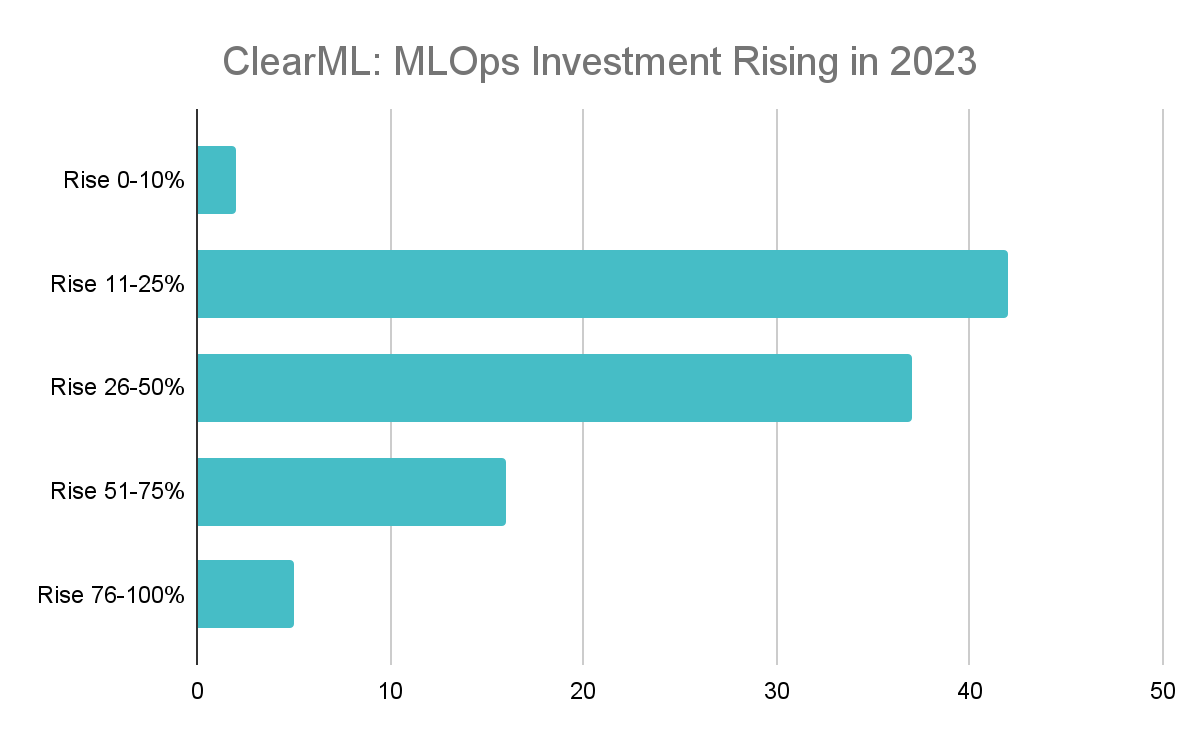As the utilization of machine learning and MLOps (machine learning operations) continues to gain traction within organizations, it is imperative to stay abreast of the latest advancements and developments in the field.
In light of this, ClearML is proud to announce the release of our latest research report, “MLOps in 2023: What Does the Future Hold?” This comprehensive study delves into the current state of the field, examining key trends, opportunities, and challenges, as well as analyzing the potential impact of the current economic climate on the implementation of machine learning and MLOps.
The report is designed to cater to a diverse audience, providing valuable insights for both seasoned machine learning experts and newcomers to the field.
Methodology
The research was conducted by polling 200 U.S.-based machine learning decision makers, providing a broad perspective on the industry. This report serves as an essential tool for organizations looking to stay ahead of the curve in the rapidly evolving world of data and technology.
Challenges in Operationalizing ML Undercut Opportunities
When surveyed about the difficulties they faced in utilizing ML to generate business and commercial value, a vast majority of respondents (86%) agreed that their organizations struggled with this task. The challenges were particularly pronounced for nearly one-third of those surveyed (29%), who stated that they were “very challenged” in creating value from their ML investments by deploying and scaling ML pipelines and projects.
In a similar vein, a majority of respondents (71%) acknowledged that their company was failing to generate revenue or create value as a result of difficulties in implementing ML on a large scale. These challenges were perceived as quite severe by nearly half of those surveyed (45%), with many describing them as “severe” or “very severe.”
Takeaway
ML has the potential to deliver significant value to businesses across a wide range of industries. However, realizing that value is contingent on effectively operationalizing ML models, a task that is becoming increasingly challenging for many organizations. This is where MLOps comes in, an approach that is designed to address the operational challenges of ML and help organizations to better leverage its benefits.
Here are five ways in which MLOps can help organizations overcome these challenges:
- Improved collaboration: MLOps practices promote collaboration between data scientists, engineers, and other stakeholders throughout the ML model development and deployment process, ensuring that everyone is working towards a shared goal and minimizing silos of information.
- Enhanced project management: MLOps provides a framework for project management that helps teams to better plan, execute, and track ML projects, reducing the risk of delays and other operational issues.
- Streamlined operationalization: MLOps helps to automate and streamline the process of operationalizing ML models, reducing the time and effort required to move a model from development to deployment.
- Better monitoring and maintenance: MLOps provides tools and best practices for monitoring and maintaining ML models in production, allowing organizations to quickly identify and resolve issues that may affect performance.
- Improved scalability: MLOps enables organizations to scale their ML models and operations to meet the needs of a growing business, without compromising on performance or security.
MLOps is seen as a critical approach in addressing the operational challenges that organizations are facing when it comes to ML, and its adoption will continue to grow as more businesses aim to capitalize on the value of ML.
Under Layoff Crunch, Data Science Teams Forced to Do More With Less
In light of the recent economic uncertainty and the resulting layoffs and hiring freezes at major tech companies such as Twitter, Microsoft, Alphabet, Meta, Amazon, and others, it is perhaps not surprising that a lack of talent was identified as a significant challenge in operationalizing machine learning (ML) on a large scale within organizations. Nearly one-third (29%) of respondents polled cited this as their biggest challenge.
Takeaway
The operationalization of ML at scale and the generation of value through it has long been a challenge for many organizations, largely due to a shortage of skilled talent in the field. The recent economic downturn and resultant layoffs in the industry have only exacerbated this issue, as organizations now find themselves with fewer resources and increased pressure to deliver results.
This has led companies to explore alternative solutions such as automation and MLOps tools to address the operational challenges and bridge the talent gap. MLOps is an approach that helps organizations to automate and streamline the process of operationalizing ML models, reducing the time and effort required to move a model from development to deployment. Additionally, it also provides tools and best practices for monitoring and maintaining ML models in production, allowing organizations to quickly identify and resolve issues that may affect performance.
In this scenario, where organizations are facing a shortage of talent, it becomes imperative to adopt MLOps to ensure that they can still operationalize ML at scale, drive value, and stay competitive. This approach can help organizations to do more with less, and overcome the challenges of talent shortage and operationalizing ML at scale.
The research findings also highlight the importance of effective talent management and retention strategies, as well as the need for organizations to invest in training and development programs to ensure that they have the necessary skills and expertise to successfully operationalize ML. Additionally, this may also indicate the need for organizations to explore alternative solutions such as outsourcing, or leveraging managed services for operationalizing ML.
MLOps Has Gone Mainstream
MLOps aims to optimize and streamline the process of developing, deploying, and ML models at scale. It encompasses a wide range of best practices, tools, and technologies that enable organizations to commercialize their ML initiatives, by continuously orchestrating and automating various ML workflows. This approach has gained significant traction in recent years, as organizations seek to capitalize on the benefits of ML while addressing the operational challenges it poses.
According to our own study, MLOps has achieved wide-scale adoption within companies and enterprises. The study found that 85% of respondents had a dedicated budget for MLOps in 2022, while an additional 14% of respondents did not have budgets in place but expected to allocate funding for MLOps in 2023. This indicates the growing importance of MLOps in the industry, as more organizations recognize the need to optimize and automate their ML workflows to drive value and stay competitive.
Takeaway
As organizations invest billions of dollars into ML, it is crucial to have an effective approach to operationalize and manage ML models at scale. MLOps includes everything from experiment, development, and deployment, to management, observability, and governance of ML models. By adopting MLOps, organizations can improve the performance of their models, speed up the process of operationalizing ML, and realize commercial value, ensuring ROI for growing ML investments.
However, the process of adopting a new MLOps platform can be complex and challenging. To help organizations navigate this process, it is essential to consider the following 5 questions when investing in and adopting a new MLOps platform:
- How does the platform integrate with existing tools and technologies?
- How does the platform handle data privacy, security, and compliance?
- What kind of support and resources does the platform provider offer?
- How does the platform support continuous integration and continuous delivery?
- How does the platform handle version control and experiment management?
By considering these questions, organizations can ensure that they choose an MLOps platform that meets their specific needs and requirements, and that can help them to automate and orchestrate their ML workflows more efficiently and effectively. Automation is key to gaining and maintaining scale and competitive edge, especially in times when resources are limited by challenging market conditions
MLOps Investments to Surge in 2023
In 2023, the majority of surveyed organizations plan to significantly increase their investments in MLOps. Specifically, 42% of respondents stated that their organization plans to increase spending by 11-25%, 37% by 26-50%, 16% by 51-75%, 5% by 76-100%, and only 2% by 10% or less. This indicates a clear trend towards a significant increase in investment in the field of MLOps.
Furthermore, an overwhelming 98% of respondents plan to increase their investments by at least 11%, with 58% of respondents planning to increase spending by over 25%. These numbers demonstrate a strong commitment to MLOps and a belief in its potential for driving business growth.
It is worth mentioning that these numbers are significantly higher than Gartner’s projection of a 5.1% growth in overall IT-related spending for the year, which highlights the growing importance and value that organizations place on MLOps and the potential it holds for the future.
Takeaway
ML investments are crucial for companies looking to optimize their resource allocation and ensure a positive return on investment. MLOps, the practice of applying DevOps principles to ML, can support better ML measurability in several ways.
- Defining clear and measurable goals for ML projects at the outset: MLOps can help companies establish clear and measurable goals for their ML projects, which will serve as a benchmark for evaluating the success of the project.
- Regularly monitoring and tracking progress against these goals: MLOps can support the regular monitoring and tracking of progress against these goals, allowing companies to quickly identify any areas where the project may be falling short and make adjustments accordingly.
- Establishing a process for collecting and analyzing data on the performance of ML models: MLOps can help companies establish a process for collecting and analyzing data on the performance of their ML models, which can provide insights into model performance and inform future iterations of the model.
- Identifying and addressing bottlenecks or inefficiencies in the ML workflow: MLOps can help companies identify and address bottlenecks or inefficiencies in the ML workflow, which can improve the efficiency of the overall ML process and lead to cost savings.
- Continuously testing and iterating on ML models to improve performance over time: MLOps can support the continuous testing and iteration of ML models, which can help to improve model performance over time and ensure that the model remains effective in changing business conditions.
Overall, MLOps can help companies to better measure the outcomes and key performance indicators (KPIs) of their ML investments, allowing them to drive innovation while making informed decisions about resource allocation and ensure a positive return.
—
As organizations continue to seek ways to improve their operations and decision-making processes, machine learning and MLOps will remain important areas of focus in the coming year.
This study has examined the latest developments in these technologies and how they can drive business value, as well as the key challenges and opportunities facing organizations as they seek to implement and operationalize ML. While operationalizing ML remains a challenge for many organizations, the widespread adoption of MLOps and the continued development of new tools and techniques offer hope for overcoming these obstacles and realizing the full potential of machine learning.
As the field continues to evolve, it will be important for organizations to stay up-to-date on the latest developments and best practices to ensure they are able to effectively leverage these technologies to drive business value in the coming year.


